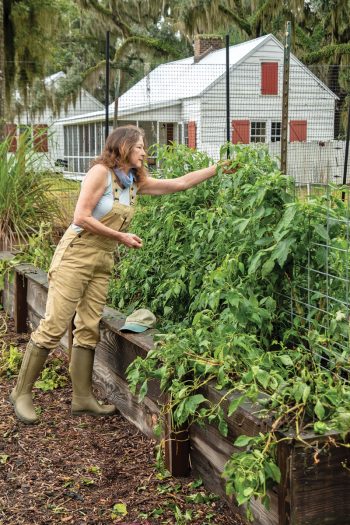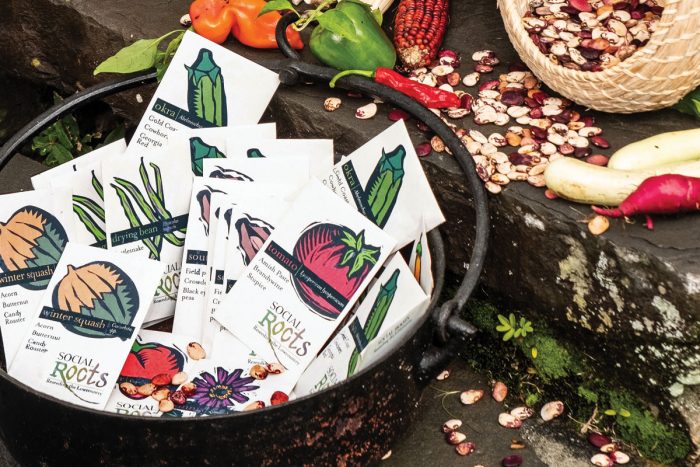The Lowcountry of the Southeastern United States—a stretch of land that spans coastal South Carolina and eastern Florida—has a long agricultural history. Once home to a handful of Native tribes, it was violently colonized in the 17th century by the English after earlier failed French and Spanish attempts. Using enslaved Indigenous and African laborers, the English built a vast plantation empire that ran, mostly, on rice.
But a confluence of cultures, mashed together by oppression, produced a rich, hodgepodge local cuisine based on corn and squash from the Americas, pigs and brassicas from Europe, and field peas, okra, and sesame from Africa. A quintessential Lowcountry dish is Hoppin’ John, which is made of red peas, rice, and salt pork.
When chefs began to revive this and other 200-year-old recipes a few years back, “the oldest generation of diners said, ‘There’s something wrong,’” explains food historian David Shields. “Chefs were using a grain-commodity rice called cocodrie and California #10 black-eyed peas.” What was wrong with the dish, Shields says, is that the flavors had been eradicated by commercial monocultures.
Sarah Ross is working to change this. Three years ago, Ross, the executive director of the University of Georgia Center for Research and Education at Wormsloe (UGA-CREW), founded a (now) nonprofit seed company called Social Roots. She wants to use the organization to bring flavor back to the region. But more than that, she says, “We need to increase the repertoire of heirlooms that can meet new growing conditions brought on by climate change.” For that, she aims to get a whole lot of people growing out her seeds—and learning to save them like the critical food-security resource they are.
Reseeding the Lowcountry
Ross is hardly alone in her desire to “reseed the Lowcountry,” as her company’s tagline describes. Glenn Roberts of South Carolina grain company Anson Mills, for example, has revived heritage varietals such as Carolina Gold rice, Sea Island red peas, and benne (AKA sesame). Small local (for-profit) seed companies like Sow True Seeds and Southern Exposure Seed Exchange offer heirlooms and landrace varieties such as Alabama blue collards, Georgia jet sweet potatoes, and the rare White Stoney Mountain watermelon.
For her part, Ross in 2016 started pulling together heirloom crop seeds—beans, okras, squashes, peanuts—that were either historically grown in the region, or that might since have become climatically appropriate. They come from the USDA’s seed banks, more than a dozen local seed companies, and from swaps Ross has participated in for years. After researching the varietals’ deliciousness and resilience, she whittled her possibilities down to 470 varieties of fruits and vegetables. Then she started growing the seeds out, “to see which ones have the widest range of tolerance to erratic weather patterns, so they can adapt,” she says.

Photo by Bill Durrance.
Ross conducts field trials on two farms. One is on the site of the former Wormsloe Plantation in Savannah, where she’s received permission to farm for free in the sandy soil of the oldest agricultural field in Georgia. Records of 18th century life at Wormsloe—first farmed by colonizers in 1735—show that at least three varieties of corn were grown there, as well as pumpkins, tomatoes, sugarcane, and the black runner peanut, which Ross is raising on-site. She says it’s “finicky to cultivate, but its flavor is out of this world—deep, sweet, like a toasted pecan.”
The other farm is Ross’s own heavy-clay-soil acreage in northern North Carolina, which sits at an elevation of 3,000 feet and is outside Lowcountry borders. “Everything about these locations is very different,” she says. “I want to make sure the seeds I distribute are indomitable, so a 10-year-old child without adult supervision could be successful growing them, and that they’ll work almost anywhere.”
Last year was the most difficult growing season Ross can remember, with hotter hot days, warmer cold days, and an overabundance of ravenous insect pests. Climate change is handily making the case for the relevance of her project.
Giving It All Away
Ross is drawn to what she calls “the most typical Southern foods.” She’s trialed 37 varieties of collard greens—chosen after an exploratory trip to Seed Savers Exchange in Iowa—seven varieties of sweet potatoes, seven kinds of kale, and 40 types of okra. The brassicas have been especially challenging to raise for seed, requiring half-mile isolation distances between them to keep their genetics pure. Growing them out has meant “timing the plantings to be vigilant about not having flowers blooming from multiple varieties at the same time,” she says. In the end, if there ever is such a thing, she’d like to further reduce her seed varieties to 150.
Last year, having registered Social Roots as a nonprofit, Ross implemented the next phase of her project: giving seeds away. Anyone can request seeds through Social Roots’ website; she’s sent packets to people in more than a dozen states, no more than two per customer. Ross says making money is “almost the antithesis of the point for me,” and that her focus is on empowering local communities to take charge of their own food security.
“What Sarah is doing is make people aware of their own agency in this changing world,” says Ira Wallace, a worker/owner at the Southern Exposure Seed Exchange cooperative. “She sees the possibility to reinvigorate individual participation in the food system, not just as cooks and eaters, but as growers again.” For Ross’s “gift economy” approach to work, free access to Wormsloe’s land helps, as do small, anonymous donations.

Photo by Bill Durrance.
Throughout spring and summer of 2019, Ross handed out a total of 1,600 seed packets to shoppers at five farmers’ markets in North Carolina, South Carolina, Virginia, and Georgia, doling out advice as well, giving talks to garden groups and clubs. She sent other packets on to interested gardeners at state parks, historic sites, Charleston’s public libraries, and churches. Some recipients promptly started growing them out and sending her photos, “of plants growing behind their house, in pots and rows,” she says. “They text me about what they’ve done and how excited they are.”
What she’s hoping they’ll all do next is save seeds from the crops they’ve grown—what Wallace calls the critical, “traditional activity to maintain diversity, so we’ll have choices in an unpredictable future.”
A colleague of Ross’s, Luke Roberson, grew out rattlesnake beans and candy roaster squash this past spring in Richmond Hill, Georgia. As Adopt-a-Wetland program coordinator at UGA’s Extension, Roberson is keenly aware of the need for seeds that can withstand the Lowcountry’s “saltier water due to seawater rise, droughts becoming more common, and the fact that it’s becoming harder and harder to find water to keep backyard gardens going,” he says.
Beyond the academic necessity of the enterprise, he says he also enjoyed the simple act of “stripping” dried beans with his son, “I grew up doing this kind of thing with my family in Kentucky, sitting around and snapping beans for hours and hours. It was a good family bonding moment.”
Sharing Seeds, Across the Planet
Historian David Shields thinks that “reseeding” on a transformative scale requires the input of many—including institutions like the Carolina Gold Rice Foundation (not related to genetically modified Golden Rice) that he and Ross both sit on the board of, which aims to restore regional grains; and universities that educate young farmers on specialty crops that will bring them a high price in the marketplace. But he also thinks Ross’s act of putting seeds into the hands of regular folks is necessary to “disrupt humans from their sense that food comes from the grocery store.”
Ross points out that seed archives are fragile, and easily lost. She tells of giving back okra seeds she’d received from the noted, now-deceased Gullah-Geechee historian Cornelia Bailey, whose family had grown them since the 1800s, to Bailey’s son, who no longer had any, and the beauty of reestablishing deep agricultural roots. To her, this kinds of hyper-localized community efforts, rather than those of large international seed banks, are where the real work of global food security lies. “As phenomenally important as the USDA [seed banks] and the Svalbard [Global Seed Vault] are, they are repositories for biodiversity, not places we can call up to get seeds to plant five acres of corn,” she says.
As Ross gets ready to continue her trials in the 2020 growing season, she’s also hoping that she gets enough donations in the coming months to hire a student assistant to set up community gardens with her product. In such places “all across the planet,” she envisions gardeners young and old, new and established, growing the seeds that we “need to share, or risk losing forever.”